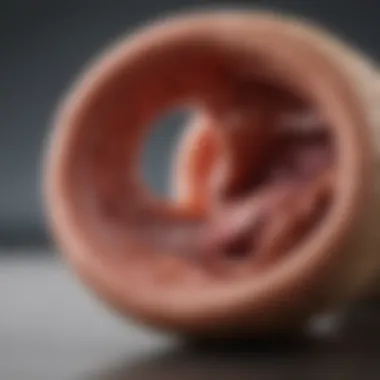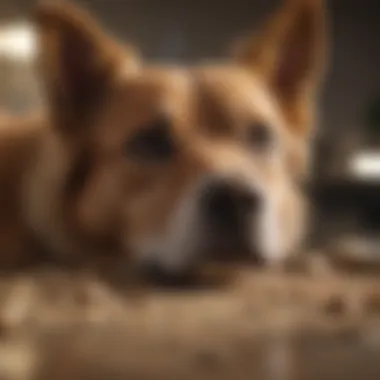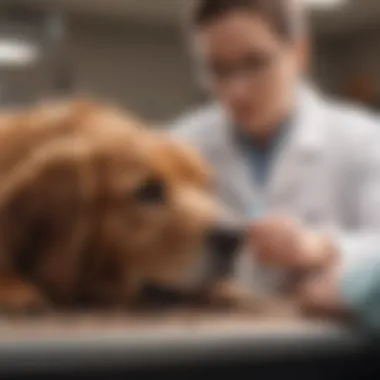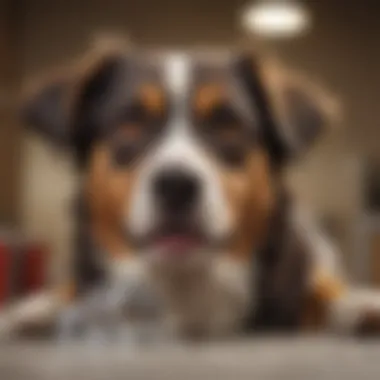Intestinal Obstruction in Dogs: A Comprehensive Guide


Intro
Intestinal obstruction is a critical issue in canine health, demanding attention from all pet owners. The condition can arise due to several factors, such as foreign bodies, tumors, or even dietary indiscretion. Understanding how these obstructions occur and recognizing the signs early on can significantly affect outcomes. In this comprehensive guide, we will explore the various aspects related to intestinal obstruction in dogs, aiming to provide pet owners with the knowledge they need to manage, treat, and ultimately prevent this serious health concern.
Understanding Your Pet
Breed Traits
Certain dog breeds are more predisposed to developing intestinal obstruction compared to others. Brachycephalic breeds, like Bulldogs and Pugs, often suffer from specific gastrointestinal issues due to their anatomy. Larger breeds, such as Great Danes, can also be at risk due to their size and eating habits, which can lead to bloating and twisting of the stomach, impacting the intestines as well.
Common Temperaments
The temperament of your dog can indirectly affect their likelihood of experiencing intestinal obstruction. Dogs that are overly curious or have a habit of chewing on random objects may ingest items that cause blockages. Understanding your pet’s behavior can help you take proactive measures.
Special Needs
Dogs that have undergone previous surgeries or have other health problems may have special needs that increase their risk for intestinal obstruction. Awareness of these needs is important for their overall health.
Pet Care Essentials
Nutrition and Feeding Guidelines
Proper nutrition plays a vital role in preventing intestinal blockages. Feeding high-quality, digestible food can lessen the risk of obstructions. It is crucial to monitor your dog's food intake. Avoid giving them access to scraps or human food that can lead to indiscriminate eating habits.
Grooming Tips and Techniques
Regular grooming reduces the risk of hairballs and ingesting foreign materials, which can cause blockages. Brush your dog frequently, especially during shedding seasons, to minimize ingestion of loose fur.
Health and Wellness
Routine veterinary check-ups are essential. Regular wellness exams can help detect underlying issues, such as mass growths, that may lead to intestinal obstruction. Vaccinations and parasite control are also important components of overall health.
Training and Behavior
Basic Training Techniques
Training your dog to avoid eating foreign objects is essential. Teach commands such as
Understanding Intestinal Obstruction
Intestinal obstruction is a crucial topic in veterinary health. It refers to a blockage in the intestines that can lead to serious complications for dogs. Understanding it involves recognizing how this condition arises, its significance, and the impact it can have on canine health.
When a dog experiences intestinal obstruction, multiple factors may contribute, including foreign bodies, tumors, and other conditions. Knowing what these elements are aids in early recognition and management. Pet owners who understand the signs and symptoms are better equipped to seek prompt veterinary assistance, which is vital for recovery.
Definition and Overview
Intestinal obstruction is defined as the interruption of normal intestinal flow. This condition can disrupt the absorption of nutrients and impede waste elimination. It manifests in various forms, such as partial or complete obstruction. A complete blockage halts all digestive processes, while a partial one allows some contents to pass.
The severity of intestinal obstruction varies. In mild cases, the dog may show few symptoms, while severe cases can lead to life-threatening situations. Timely intervention is essential. Recognizing obstacles that can cause obstruction, such as ingesting foreign objects, can save lives.
Anatomy of the Canine Digestive System
The canine digestive system consists of several key parts including the mouth, esophagus, stomach, small intestine, and large intestine. Each part plays an important role in the digestion and absorption of food. The small intestine, for instance, is vital because it is where most nutrient absorption occurs.
The intestines are divided into two main sections: the small intestine and the large intestine. The small intestine includes the duodenum, jejunum, and ileum. Each section has distinct functions in breaking down food and absorbing nutrients.


When obstruction occurs, it typically happens in the small intestine due to its smaller diameter compared to the large intestine. Complications can include perforation or infection, leading to drastic health consequences. Understanding this anatomy helps pet owners appreciate the serious nature of intestinal obstruction and underscores the importance of monitoring their dog's health continuously.
Comprehensive knowledge about your dog's digestive system enriches your ability to notice unusual behaviors or symptoms.
Common Causes of Intestinal Obstruction
Understanding the common causes of intestinal obstruction is crucial for pet owners. Identifying these factors can lead to better preventive measures and quicker interventions when necessary. This section highlights the main culprits behind this serious condition, offering clarity to concerned pet owners. With a better grasp of potential causes, individuals can monitor their dogs more effectively.
Foreign Objects Ingestion
Dogs are notorious for their curious nature. They often explore their environment with their mouths. This behavior can lead to the ingestion of various foreign objects, such as toys, bones, and even clothing. These objects can become lodged in the intestines, causing a blockage. Symptoms may include vomiting, inability to pass stool, and abdominal pain.
Veterinarian assistance is vital in these cases. If an object is large, surgical intervention might be required. Prevention is essential. Pet owners should supervise their dogs during playtime and regularly check for items that might pose a choking hazard.
Intestinal Tumors
Tumors can develop in various parts of the gastrointestinal tract. Benign or malignant growths can lead to obstructions by narrowing or blocking the intestinal passage. It is essential to note changes in your dog's behavior and health. Signs to watch include weight loss, vomiting, or changes in appetite.
Early detection through veterinary examination is crucial. Imaging techniques, such as ultrasound, can help determine the presence of tumors. In some cases, surgical removal may be necessary, combined with other treatments such as chemotherapy for malignant tumors.
Intussusception
Intussusception occurs when a segment of the intestine telescopes into an adjacent segment. This condition leads to obstruction and can cause severe pain and damage to the affected area. Dogs may exhibit symptoms like lethargy, vomiting, and a swollen abdomen.
Immediate veterinary attention is required. Timely diagnosis is critical because it can lead to tissue necrosis if left untreated. Surgical intervention is often necessary to correct the condition and remove any damaged tissue.
Strictures and Adhesions
Strictures are abnormal narrowing of the intestine, which can develop due to inflammation or previous surgeries. Adhesions are bands of scar tissue that connect different parts of the intestines, leading to blockages. Both conditions can significantly impair digestion and food passage. Symptoms can vary, including poor appetite, vomiting, and abdominal distress.
Regular veterinary check-ups can help monitor such conditions. Depending on severity, surgical intervention could be the solution to remove the blockage and restore normal intestinal function.
Understanding these causes is key for proactive pet care. Always consult with a veterinarian if you suspect your dog might have an intestinal obstruction. Recognizing the symptoms early can save lives.
Recognizing Symptoms of Intestinal Obstruction
Understanding how to recognize the symptoms of intestinal obstruction in dogs is critical. Early detection can be the difference between life and death. Pet owners must be alert to changes in their dog's behavior and physical condition. Symptoms may not always be obvious, and some can resemble other health issues, but knowing them can lead to timely intervention. This section will discuss common clinical signs, including vomiting, abdominal pain, loss of appetite, and the distinction between diarrhea and constipation, as well as behavioral changes that may indicate a problem.
Common Clinical Signs
Vomiting
Vomiting is one of the first signs that may indicate intestinal obstruction in dogs. It can manifest in different forms, such as multiple episodes or severe retching. The frequency and characteristics of the vomit, including presence of bile or undigested food, can provide important clues. Notably, vomiting in dogs can lead to dehydration, impacting overall health. Consequently, recognizing this symptom can prompt immediate veterinary attention, making it a crucial part of the symptoms spectrum.
Abdominal Pain
Abdominal pain is another important symptom. Dogs may show signs of distress like whining, pacing, or adopting unusual positions, such as hunched posture. This behavior reflects discomfort. Dogs might also react negatively to touch around the abdomen. Identifying abdominal pain can help in assessing the severity of the obstruction. Knowing this symptom can guide owners to seek urgent care, further emphasizing its significance in this article.
Loss of Appetite
A sudden loss of appetite often accompanies intestinal obstructions. Dogs may refuse to eat, which can be alarming for any owner. This symptom indicates that the dog's body is not functioning normally. The loss of meal interest could lead to further health complications, such as malnutrition. Understanding this symptom is essential, as it can reflect underlying issues that need veterinary assessment.
Diarrhea vs.
Constipation
Differentiating between diarrhea and constipation is vital. Both conditions can indicate intestinal obstruction, but they lead to different implications. Diarrhea could pertain to an obstruction that constricts the balance in the intestines. In contrast, constipation often shows a full blockage. Observing the dog's elimination habits can help owners make informed decisions on when to seek veterinary assistance. Clarity in this distinction is beneficial, as it directs treatment approaches and monitoring needs.


Behavioral Changes in Affected Dogs
Behavioral changes in dogs can serve as subtle yet significant indicators of intestinal obstruction. Affected dogs often display anxiety, lethargy, or agitation. They may seek a quiet place, avoiding interaction or normal play activities. This withdrawal can raise red flags for observant owners. Monitoring behavioral shifts can aid in identifying problems promptly. An understanding of these changes contributes to effective management of a dog's health, ensuring better outcomes when addressing possible obstructions.
Diagnosis of Intestinal Obstruction
Diagnosis of intestinal obstruction is a crucial step in managing this serious condition in dogs. Early identification and action can significantly improve the chances of a successful outcome. Timely diagnosis aids veterinarians in determining the best course of treatment, which can involve surgery or medical management. Understanding the signs, conducting thorough examinations, and utilizing advanced diagnostic tools are essential for effective intervention.
Veterinary Examination
A comprehensive veterinary examination serves as the first line of defense against intestinal obstruction. The veterinarian conducts a physical examination, focusing on abdominal palpation to detect any abnormalities. Signs such as bloating, pain, or rigidity may indicate a blockage. The dog's history, including any recent changes in behavior, eating habits, or incidents of foreign object ingestion, can provide vital clues. Blood tests may also be performed to check for dehydration or infection, which can further inform the diagnosis.
Diagnostic Imaging Techniques
Effective diagnostic imaging is vital for confirming intestinal obstruction. Several techniques can visualize the abdominal area and assist in determining the obstruction's location and severity.
X-rays
X-rays are a commonly used diagnostic tool for detecting intestinal obstruction. This method is non-invasive and can quickly reveal any signs of gas patterns or foreign bodies in the digestive tract. One key characteristic of X-rays is their ability to provide a rapid assessment of the dog's condition. However, they may not always show soft tissue structures clearly. Therefore, while they are useful for preliminary evaluation, additional imaging may be necessary for a complete diagnosis.
Ultrasound
Ultrasound is another effective imaging technique for diagnosing intestinal obstruction. This method allows for real-time visualization of the abdominal organs, offering clear images of soft tissues. The non-invasive nature of ultrasound also minimizes discomfort for the dog. A key advantage is its ability to help veterinarians assess the movement of the intestines, identifying any areas of reduced activity or thickening. However, ultrasound requires a skilled technician and may not always be widely available.
CT Scans
CT scans provide a detailed cross-sectional view of the abdominal organs, making it a powerful tool for diagnosing intestinal obstruction. This imaging technique is especially beneficial for its high-resolution images, which can reveal small abnormalities that other methods might miss. The key characteristic of a CT scan is its precision and speed in providing comprehensive information. Nevertheless, it typically requires sedation, which poses risks for some dogs.
Comparative Diagnosis
In making a definitive diagnosis, veterinarians often conduct comparative diagnostics. This involves using findings from physical examinations and various imaging techniques to confirm the presence of an obstruction. It is important to differentiate intestinal obstruction from other conditions that can mimic similar symptoms, such as pancreatitis or gastrointestinal upset. An accurate diagnosis helps ensure the appropriate course of treatment is recommended, thus enhancing the canine's chances of recovery.
Proper diagnosis is critical; it directly impacts treatment options and recovery outcomes.
Treatment Options for Intestinal Obstruction
Treatment choices for intestinal obstruction in dogs are vital for recovery and can significantly influence the dog's outcome. The methods for addressing this serious condition include surgical and medical approaches, each tailored to the dog's specific situation. Prompt intervention can reduce risks, alleviate discomfort, and enhance the pet's overall well-being.
Surgical Intervention
Surgical intervention is often the most effective method for treating intestinal obstruction. This option becomes necessary in cases where there is a complete blockage or if foreign objects are present in the digestive tract. During surgery, veterinarians can remove the obstruction, repair any damaged intestine, and ensure proper function returns.
There are various surgical techniques employed depending on the nature of the obstruction. Some may require exploratory surgery, where the veterinarian inspects the intestines directly. In other cases, less invasive techniques might be considered if the situation allows. The risks associated with surgery include infection and the possibility of complications during recovery. However, when conducted by an experienced veterinary surgeon, the benefits generally outweigh these risks.
Medical Management
Medical management is another path that can be taken, particularly for less severe obstructions. This approach typically includes conservative measures such as administering fluids, dietary adjustments, and medications to ease nauseous feelings. Monitoring the dog's condition closely is essential; if symptoms do not improve, surgical options may still be needed.
In some situations, veterinarians may also use medications that promote bowel motility. These help to stimulate movement through the digestive tract, assisting in clearing partial obstructions. While this strategy can be effective, it also requires careful monitoring to avoid any complications or worsening of the condition.
Post-operative Care
Post-operative care is crucial for the recovery of dogs that undergo surgery for intestinal obstruction. After the procedure, the dog should be monitored closely for any signs of complications such as vomiting, lack of appetite, or distress. Pain management is an important aspect of this phase, and veterinarians typically prescribe pain relief medication to aid in comfort during recovery.
Additionally, a gradual return to normal diet is necessary. Initially, the dog may be fed a bland diet and monitored for reactions. Reintroducing regular food must be done slowly and cautiously, taking care to avoid any items that could lead to a re-obstruction.
Routine follow-ups with the veterinarian will help ensure that the dog is healing properly and any signs of recurrence are caught early. By addressing both surgical and medical management combined with diligent post-operative care, pet owners can significantly improve their dog's chances for a full recovery.


Effective treatment can greatly enhance a dog's quality of life and ensure a swift recovery, so vigilance and adherence to recommended care are crucial.
Preventive Measures to Avoid Intestinal Obstruction
Preventing intestinal obstruction in dogs is crucial for maintaining their health and well-being. By understanding the steps to take, pet owners can significantly reduce the risk of this serious condition. The measures discussed here focus on dietary management, safe play habits, and regular veterinary examinations. Each aspect plays a pivotal role in ensuring your dog's digestive system operates smoothly.
Dietary Considerations
Feeding your dog a balanced diet is fundamental to preventing intestinal obstruction. A well-regulated feeding schedule with proper portion sizes helps maintain healthy digestion. It's also important to choose high-quality dog food that is appropriate for your dog's age, size, and activity level.
When introducing any new food, do so gradually to allow your dog's digestive system to adjust. Watch for any adverse reactions. Some of the key dietary considerations include:
- Avoiding Human Food: Many human foods, such as bones or fatty scraps, can cause intestinal blockages.
- Inspecting Chew Toys: Some dogs chew on toys that can break off and cause blockages. Select durable chew items.
- Moderating Treats: Treats should complement the main diet and not lead to weight gain or poor digestion.
By managing dietary choices, you can help safeguard your dog's gastrointestinal health.
Safe Play Practices
Playtime is essential for your dog's physical and mental well-being. However, not all toys are safe, and play habits need monitoring. Risky play can lead to swallowing harmful objects that result in obstruction. Here are some safe play practices:
- Supervise Playtime: Always watch your dog during play to prevent them from eating inappropriate objects.
- Choose Appropriate Toys: Select toys that are the right size for your dog. Ensure they cannot swallow them easily or break them apart if chewed.
- Teach Fetch with Caution: The fetch game can lead to ingestion of items mistaken for toys. Use items specifically meant for fetch.
Implementing these practices can help create a safer play environment and reduce the chances of intestinal issues.
Regular Veterinary Check-ups
Regular visits to the veterinarian are a key preventive measure. Routine check-ups allow for the early detection of any potential health concerns, including those that may lead to intestinal obstruction. Ensure your dog has vaccinations up to date and discuss any dietary changes or behavioral issues with your vet.
- Health Monitoring: Routine assessments can spot signs of weight changes, dehydration, or digestive trouble before they escalate.
- Professional Guidance: Your vet can recommend suitable foods, supplements, or adjustments in diet tailored for your dog's needs.
- Early Intervention: Quick veterinary response to any emerging issues can prevent serious complications associated with intestinal obstruction.
Prognosis and Long-term Effects
Understanding the prognosis and long-term effects of intestinal obstruction in dogs is essential for pet owners. This information helps gauge the recovery journey your pet may face and informs decisions about ongoing care, lifestyle adjustments, and preventive measures.
Factors Affecting Recovery
Recovery from intestinal obstruction typically varies based on several factors. Key elements include the surgical approach used, overall health prior to the obstruction, and the type of blockage encountered.
- Timeliness of Treatment: Early intervention can significantly improve outcomes. The longer a blockage remains untreated, the greater the risk of damage to the gastrointestinal tract.
- Age and Health Status: Younger, healthier dogs often recover faster than older ones, or those with pre-existing conditions.
- Type of Obstruction: Each obstruction has unique characteristics. For example, a foreign object may require less recovery time than a tumor.
- Surgical Technique: The skill of the veterinarian and the technique used in surgery can influence recovery time. Complex surgeries may lead to longer recuperation periods.
- Post-operative Care: Adhering to post-operative care guidelines is crucial. This can include dietary modifications and limiting activity levels to promote healing.
Recovery from intestinal obstruction requires comprehensive care. Monitoring and supporting your pet plays a vital role in a successful outcome.
Monitoring for Recurrence
Once a dog has experienced intestinal obstruction, vigilance is essential for monitoring recurrence. It is not uncommon for pets to face additional blockages, especially if the underlying cause was not resolved.
- Regular Veterinary Check-Ups: Schedule follow-up visits to assess the gastrointestinal health of your dog. Your vet can provide valuable insights on any emerging symptoms you should watch for.
- Home Observation: Keep an eye on your dog's eating habits, stool consistency, and behavior. Unexplained changes could signal a potential problem.
- Dietary Adjustments: Following surgical recovery, it may be advisable to adjust your dog's diet to reduce the risk of future obstructions. Consult your veterinarian about appropriate food options.
- Behavioral Signs: If your dog exhibits signs of pain, vomiting, or lethargy, it is imperative to seek veterinary advice immediately. These may indicate a recurring issue.
By staying proactive about both recovery and potential recurrence, pet owners can enhance their partner's quality of life and overall health.
End
Understanding intestinal obstruction in dogs is vital for every pet owner. This condition can quickly escalate from a minor issue to a life-threatening situation. Recognizing the signs early and acting swiftly can dramatically improve outcomes and recovery rates.
Summary of Key Points
- Prevalence of Intestinal Obstruction: This condition can occur in dogs of any age and breed. Dogs tend to be curious and may ingest foreign objects, leading to blockages.
- Symptoms to Watch For: Look out for persistent vomiting, lethargy, abdominal pain, and changes in appetite. Each of these symptoms can be a red flag for obstruction.
- Diagnostic Approaches: A veterinary examination, combined with diagnostic imaging like X-rays and ultrasounds, is essential for accurate detection.
- Treatment Options: Surgical intervention may be necessary, but many cases can be managed with medical treatment. Post-operative care is equally important for a successful recovery.
- Preventive Measures: Maintaining a proper diet, supervising playtime, and regular vet visits help minimize risks.
Final Thoughts on Pet Health
Investing time to understand intestinal obstruction not only enhances your dog's health but also strengthens the bond between you and your pet. A proactive approach can mean the difference between an emergency situation and a healthy, happy life for your dog. Educate yourself and stay vigilant, as early detection and intervention are your best tools against intestinal obstructions.
Remember: If you suspect your dog may have an intestinal obstruction, contact your veterinarian immediately. Time is crucial.



